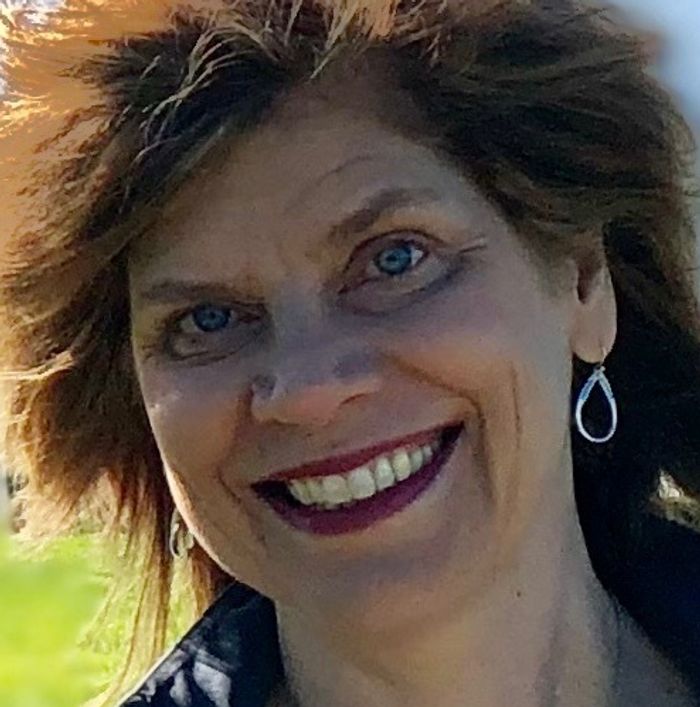In June, Janet Sharkis watched in dismay as the money that funded her nonprofit job dried up, putting her out of work after decades in the field.
The 58-year-old single mother with one daughter in college and another about to start her senior year of high school was upset, angry, and scared about what her next move would be in a sector where it can be difficult to land a senior-level position.
“My expenses are going to go up, and my income is probably going to go down. ….I knew I was going to have a tough road,” the Austin, Texas resident said.

‘My expenses are going to go up, and my income is probably going to go down. ….I knew I was going to have a tough road.’
Photo courtesy Janet Sharkis
But there were more than 10 million job openings in the country at the time, with many employers desperate for labor. So, Sharkis would have no problem, right?
What happened next highlights the challenges and opportunities that coexist in today’s job market. It’s also a tale of personal reinvention to surmount those obstacles and snag the golden opportunities. That’s a task many older workers may have to figure out, some observers say, especially if they face the headwinds of age discrimination.
After months of searching, Sharkis switched from nonprofit administration to for-profit sales, working for Social Solutions, a software company geared towards nonprofit organizations, philanthropies and public sector agencies. She pulled off a pay raise too, going from $92,000 to a $110,000 base salary for a new job that excites her.
Sharkis started as a community development executive in October. “I’m still in disbelief. That has not gone away,” she told MarketWatch.
‘The worst part is everyone telling you you’ll get a job immediately’
Before her turn to the private sector, Sharkis was a program director in the University of Texas’ College of Education, where she focused on initiatives surrounding mental health, special education and students with disabilities. That capped years of public interest work, which began with her first job out of college as a special education teacher and turned into higher-level administrative work.
“I wanted to do something where I could have impact on people’s lives. That was important to me,” she said.
When Sharkis and another coworker were let go, she worked constantly to land similar jobs in nonprofits or the public sector. Her applications went unanswered and virtual interviews with employers or applicant screeners didn’t blossom into more.
Even with record job openings, there was competition from the millions of people leaving their jobs voluntarily. Alongside those more than 10 million openings, a record 4.4 million people quit their jobs in September, according to the Bureau of Labor Statistics.
“Everyone is looking for jobs at the same time. That makes the market very, very messy,” Sharkis said. “There were times where I would feel so very hopeless.”
The constant searching wasn’t the worst part. “The worst part is everyone telling you you’ll get a job immediately because the only people who don’t have a job now don’t want to work,” Sharkis said.
So there’s the hunt for a job and “you have stigma on top of it,” Sharkis said. “What’s wrong with you if you don’t have a job?”
Along the way, Sharkis joined Launch Pad Job Club, an organization to network and share job leads that was formed in the dust of the dot com collapse. Members are typically age 45 and up and some are either looking for a new career or another job in the same industry, said Shannon Brooke Mantrom, the organization’s executive director. Earlier in the pandemic, around 60 people attended the virtual weekly meetings and it’s now half that size, Mantrom said.
Switching jobs — let alone, careers — can be a tough prospect that may entail worker retraining and new certifications, she said. But companies have their own issues to confront in the job market, with many “crying out for help, but then they are not looking where the help is. … Believe it or not you can teach an old dog new tricks.”
More than 3 million people decided to retire early during the pandemic, according to research from the Federal Reserve Bank of St. Louis, though there are now signs some of those people are coming back to work.
Sharkis never thought about retiring early, but she knew people who were contemplating the idea. “Many of them want to work, they just are disgusted and demoralized,” she said.
‘Sometimes you have to listen to what’s in the back of your mind’
Years ago, Sharkis took continuing education courses on the business side of nonprofit management. The information was interesting, but Sharkis filed it away in the back of her mind and went back to work.
Years later, when she met her boyfriend, who works in sales, she learned what his job and his coworkers’ jobs were like. Again, she filed that away in the back of her mind and returned to work.
But then something clicked. “I sell a cause all the time,” Sharkis said. “I started to see the similarity and the common threads of the work I’d been doing for years and what they do.”
Listening, educating and building relationships are key skills for both her previous nonprofit work and sales, she noted. “It was in the back of my mind, and sometimes you have to listen to what’s in the back of your mind, that I wanted a change,” Sharkis said.
But still, how to transition?
Sharkis scheduled informational interviews to learn about sales work. Along the way, she came across a job advertisement from Social Solutions. She gave it a chance and applied. “When I first had the interview, I felt really connected to it in a way I hadn’t felt to others,” Sharkis said.
Now she works with a sales team focused on California-based nonprofit and government clients. Her job is a mix of relationship management, but also being an extra sounding board when her clients need to troubleshoot management topics and projects. It’s an exciting new learning experience that still incorporates Sharkis’ experience, she said.
Steph Austin, senior manager of community development, hired Sharkis. Sharkis’ nonprofit industry experience lets her understand the client point of view, said Austin. “I find it a lot easier to teach the mechanics of sales than to teach an entire industry,” Austin said, noting the company has increasingly hired people this year with nonprofit and public sector experience instead of a traditional sales backgrounds.
“We get better ideas and do better work when we bring in people who are not in the cookie cutter mold,” Austin said.
Advice for switching careers
Make no mistake, career switches are hard. “Generally speaking it seems we are hired to do jobs they already know for a fact you can do. …. No one wants to take a chance on someone,” Sharkis said.
One critical step for a crossover is identifying transferrable skills, said Wendy Marx, the author of “Thriving at 50+.” One exercise, Marx said, is drawing a line on a piece of paper and writing all the technical skills and softer skills, like communication, on one side. Brainstorm new fields and next steps on the other side.
Storytelling is another skill older workers need to refine. “People of my ilk, you were taught you don’t brag, your credentials speak for themselves. All of which is no longer the case. You can’t just rattle off titles. You need to illustrate how you made a profound difference in your career.”
Older workers also have to make their case in the face of potential bias or short shrift due to age discrimination, spoken or unspoken, Marx said. Ageism “doesn’t get the attention that other ‘isms’ get,” she said.
Sharkis has career switch pointers too. It’s important to build a support network, like the one the job club provided, where people understand how tough a job search can be now.
In the thick of a job hunt, someone can be in “survivor mode,” which doesn’t give much time and thought to heady issues like long-term goals, motivations and interests, Sharkis said. Try not to ignore those factors, she said. “Deep down in my heart, I wanted something that was going to be a new challenge,” she said.
Job seekers have to remember the people around them are watching and learning how they handle it. In this case, it was Sharkis’ kids. “If you want to model perseverance to kids, you’ve got to model perseverance in your job search,” she said.
After Sharkis landed her job, her daughter one day told Sharkis she was proud of her. “That made me feel I’m doing something right for her.”
Want to talk about your own job search and career moves during the pandemic? Write [email protected]








